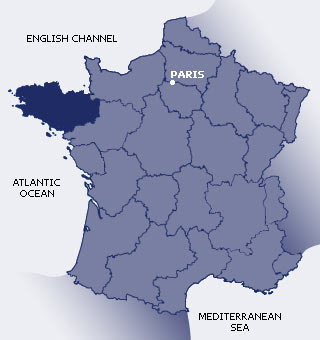 Lesson #23 wrapped up an extremely busy week. Brittany’s fat is butter. Chef started each pot or pan with a little douse of clarified butter.
Lesson #23 wrapped up an extremely busy week. Brittany’s fat is butter. Chef started each pot or pan with a little douse of clarified butter.Clarified butter has a higher smoking point – burns at a higher temperature. And is preferred when sautéing. Take a block of butter on low heat. Impurities will rise to the top – skim off and discard. The milk-solids will fall to the bottom. Leaving the liquid butter-fat on top. Gently pour off the butter-fat (clarified butter). Discarding the milk-solids. One French block (250 g) yields 180 g clarified butter.
Butter is not the only thing Brittany is known for. Tucked on the northern tip of France, nearly all bordering the Atlantic Ocean. Sea creatures of all types – clams, scallops, oysters, sea urchin, shrimp, lobster and crab – are distinct to the area.
 Bretons are salt-of-the-earth, country folk. Focusing more on local products than refined gastronomy. Until early 1900 meat wasn’t common. Nowadays, salt-marsh grazed lamb, pork, and beef roam the region.
Bretons are salt-of-the-earth, country folk. Focusing more on local products than refined gastronomy. Until early 1900 meat wasn’t common. Nowadays, salt-marsh grazed lamb, pork, and beef roam the region.Brittany is overrun by apple production. Which is almost entirely used for Calvados – apple brandy – production. Strawberries are the only other fruit worth mentioning. In terms of vegetables you can find; cauliflower, artichokes, leeks, onions, carrots, cabbage, and beets.
Instruction #23 - Brittany
- Roasted Langoustines and Brittany artichoke salad with samphire
- Monkfish wrapped in bacon with braised artichokes
- Prune flan
I love langoustines. Offered cooked at farmer’s markets. These sweet little crustaceans are a great accompaniment to any dish.
 Broiled. Wrapped in bacon. On a medley of butter-sautéed artichokes, carrots and spring onions. Drizzled with herb and cider vinaigrette. A fantastic combination.
Broiled. Wrapped in bacon. On a medley of butter-sautéed artichokes, carrots and spring onions. Drizzled with herb and cider vinaigrette. A fantastic combination. Samphire, green beans of the sea, was used as the salad component. Essentially. An edible sea plant. Seaweed-like. Uniquely Northern European. The name, samphire, is a distortion of Saint-Pierre [French] – patron saint of fishermen. Historically eaten in England and Northern France.
Samphire, green beans of the sea, was used as the salad component. Essentially. An edible sea plant. Seaweed-like. Uniquely Northern European. The name, samphire, is a distortion of Saint-Pierre [French] – patron saint of fishermen. Historically eaten in England and Northern France.Here’s a little tip. When making vinaigrette on its own. It should taste. Too acidic. And too salty. You are using it to season something else (i.e. salad). Otherwise the flavor will not come through.
 Chef Terrien intimidates me. Perhaps it’s because he’s the top chef of LCB. I don’t know. Overseeing our practical. I got the nerves.
Chef Terrien intimidates me. Perhaps it’s because he’s the top chef of LCB. I don’t know. Overseeing our practical. I got the nerves.Working on the monkfish recipe. I first burned my artichokes – which Chef forcefully pointed out. The accompaniment was pannequet – a crêpe-type pancake filled with cauliflower and broccoli. These also got a little too brown. Again, noted by Chef. To hit a homerun. I also overcooked the monkfish. Oh! And my jus was too salty. Chef’s puckered face really drove the point home. As he walked in circles smacking his lips together. Eyeing me. Thinking salty thoughts.
It was not the best day. To say the least. I will have Chef Terrien a lot in Superior. So I need to get comfortable with him. Some how. Some way.

he is there to teach you not torment you. You need to find a way into his head, to think like he thinks, to taste a bit like he tastes. You'll get there!!
ReplyDelete